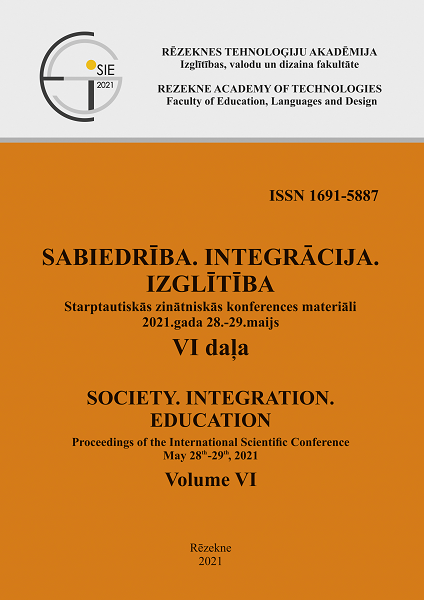STRATEGIC INTERNAL COMMUNICATION: ANALYSIS OF THE PRACTICE OF REGIONAL HIGER EDUCATIONAL INSTITUTIONS OF LATVIA
DOI:
https://doi.org/10.17770/sie2021vol6.6415Keywords:
higher education institution, internal communication, strategic management, strategyAbstract
In the organization's strategic management, internal communication is one of the main components enabling the strategic management process to be carried out. Its role is important in both the planning and implementation of the strategy. Still, in practice, the internal communication’s potential remains untapped, resulting in the pursuit of organizations' strategic objectives. In developing the doctoral thesis, the author has an interest in investigating not only businesses, but also higher education institutions (HEIs), as they are similar organizations to other sectoral institutions, and their processes must be similar. The purpose of this study is to analyse who currently manages the internal communication function of four Latvian regional universities and to what extent the internal communication can be considered strategic. The study reviews international literature on the strategic management of organizations and the strategic management of internal communication. It uses a combined research strategy involving questionnaires and semi-structured interviews with respondents indicating that their university has developed an internal communication strategy.
The results show that the internal communication management practices of universities differ since some universities do not clearly define the purpose of internal communication, strategies, and plans, as well as those which merely indicate the existence of internal communication management practices. In all four universities, specialists carry out internal communication in the field of marketing, communication, or human resources management who demonstrate that private business practices are being applied – implementing internal communication in fragmented ways without acknowledging it as a management’s function.
The research participants have indicated that internal communication should be managed by the administrative vice-rector. Since the analysed articles show that the employee responsible for the internal communication function should be part of the decision-making process, more in-depth research should be continued which would allow making conclusions whether the administrative vice-rector at the university should take on the strategic management function of internal communication.
Downloads
References
Andersson, R. (2019). Employee Communication Responsibility: Its Antecedents and Implications for Strategic Communication Management. International Journal of Strategic Communication, 13(1), 60–75.
Cowan, D. (2017). Strategic Internal Communication. How to build employee engagement and performance. Second Edition. London: Cogan Page, p.26.
Delport, M. (2020). Lost in Communication in Higher Education. Communication, 46(3), 106–126.
Falkheimer, J., Heide, M., Nothhaft, H., Sara von Platen, Simonsson, Ch., & Andersson, R. (2017). Is Strategic Communication too important to be left to Communication Professionals?: Managers’ and coworkers’ attitudes towards strategic communication and communication professionals. Public Relations Review, 43(1), 91-101.
Goodman, M. B. (2000). Corporate communication: the American picture. Corporate Communications: An International Journal, 5(2), 69–74.
Gupta, K. P., & Sengar, R. (2020). Organisational communication in higher educational institutions: scale development and validation. Int. J. Education Economics and Development, Vol. 11, No.1.
Henrique, P., Soares, L., & Del Gaudo, R. (2018). Megaphones out, Smartphones In. Practices, challenges, and dillemmas of communication with employees. San Paulo: Aberje, p.33.
Hume, J., & Leonard, A. (2013). Exploring the strategic potential of internal communication in international non-governmental organisations. Public Relations Review, 40(2), 294–304.
Invernizzi, E., Biraghi, S., & Romenti, S. (2016) Entrepreneurial communication and
the strategic role of internal communication. Retrieved from https://docplayer.net/9592459-Entrepreneurial-communication-and-the-strategic-role-of-internal-communication.html
Mišankováa, M., & Kočišováa, K. (2014). Strategic implementation as a part of strategic management. Contemporary Issues in Business, Management and Education conference. Procedia - Social and Behavioral Sciences, 110.
Mohamad, B., Bakar, H. A., Halim, H., & Ismail, A. R. (2014). Corporate Communication Management (CCM) and Organisational Performance: A Review of the Current Literature, Conceptual Model and Research Propositions. Procedia - Social and Behavioral Sciences, 155, 115–122.
Rasche, A., & Seidl, D. (2016). A Luhmannian Perspective on Strategy: Strategy as Paradox and Meta-Communication. Critical Perspectives on Strategy: Strategy as Paradox and Meta-Communication. Retrieved from https://ssrn.com/abstract=2777483
Welch, M., & Jackson, P. R. (2007). Rethinking internal communication: a stakeholder
approach. Corporate Communications: An International Journal, 12(2), 177–198.


